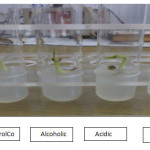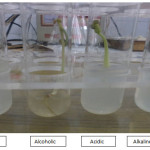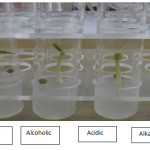Introduction
Allelopathy is the ability of plant to inhibit the germination of other plant through the production of allelochemicals that may be present in leaves,root,fruits, stems and rhizome etc. The history of allelopathy is an area of research has been reviewed.1,2 In allelopathy three criteria are followed to provide the proof of allelopathy i.e there must be production and release of chemicals by the donor or aggressor plants. They are released to the soil thorough volatilization, root exudation, leaching and decomposition of plant residues3 and affect on germination and growth of other species of plant.4,5 The effect of allelopathy when one plant strikes upon another for a common resource. Many organism species regulate the production and release of chemical attractants stimulators or inhibitors.6 Allelopathic compounds regulate plant growth and developmental processes like photosynthesis, respiration, transpiration, biochemical metabolism, protein and nucleic acid synthesis.7 Ocimum sanctumL., Calotropis procera and Astragalus tribuloides has medicinal values. These plants show the allelopathic effect on Vigna radiata L. Wilczek.8,9,10
The importance of allelopathy in crop productivity has been highly recognized.11,12,13 The number of crop species has been reported to possess the allelopathic effect on growth of other plant species.3 These plant species has been reported to have some plants.14,15 The extracts of plants have medicinal value for treatment of antifungal activity, Antibacterial activity and stopped the replication process of HIVvirus in human being.16,17,18 The Extracts of Ocimum sanctumcuring viral, bacterial and fungal infections of the respiratory system gives miraculous relief in congestion due to presence of Eugenol and Cineole in its essential oils. It is effective in curing almost all varieties of respiratory disorders including bronchitis, both chronic and acute. It also reduces the chances of ulcers and removes cough from lungs and nasal passage. Calotropis procera is known to contain cardioactive glycoside calotropine which has shown an antitumor effect in vitriol on human epidermoid carcinoma and diuretic the rhinopharyx.19 It also produce a strong cytotoxic effect on COLO 320 tumour cells aganist human colon cancer cell line.20 Alkaline extracts is used to reduce stress and fight aging and enhanced the function of T-cells to play specific roles in the immune system and for its adaptogenic effect on the heart and kidneys.21 Hence, the present study was carried out to determine the allelopathic effect of different medicinal plant extract on plumule length of Vigna radiata L. Wilczek under laboratory conditions.
Materials and Method
Collection of Plant Material
From some preliminary survey and review of prior works by other workers, it was noted that the leaf extract had the strongest allelopathic effects on plumule length, thus leaves were selected for the present experiment. Fresh leaves of medicinal plants namely Ocimum sanctumL., Calotropis procera(Ait.) Ait. f and Astragalous tribuloides Delile was collected in their vegetative growth stage from the nearby experimental fields. Extraction of plant leaves was done following the method of22 as modified by.23
Alcoholic Extract
Take 0.2 gm of the leaves sample was crushed in 1ml of 80% aqueous methanol. The sample were centrifuged at 5000 rpm for 10 minutes and supernatant was collected which is concentrated with vacuum concentrator.
Aqueous Acidic Extract
Take 1 gm of leaves were boiled in 0.2 M Hcl for 25-30 minutes. It was filtered with muslin cloth and separated out with ethyl acetate. Shake well and kept for five minutes and concentrated with vacuum concentrator, this separation was done three times with ethyl acetate. Finally, it was dissolved in 80% aqueous methanol.
Alkaline Extract
Take 0.2 gm of the leaves was boiled in 0.2 M HCl for 25-30 minutes, centrifuged at 5000 rpm for 10 minutes. Pellets kept in 2M NaOH for overnight. Then, again centrifuged at 5000 rpm for 10 minutes. Filtered with muslin cloth and pH was adjust to 2.0 with concentrated 1N HCl and separated it out with ethyl acetate and finally dissolve it in 80% methanol.
Uses of Extracts
Plumule length was performed for the alcoholic, aqueous acidic and alkaline extract of donor plants. Healthy and uniform sized seeds were selected and pre-soaked in distilled water for 2 hrs, then imbibibed in different extracts of medicinal plants for 3 hrs and control was treated as double distilled water. Seeds were eventually placed on two layers of seed germination paper in sterilized petriplates. Petri plates were kept at dark condition at 27 ̊c in moistened condition.Each treatment has three replicas and one control was run with double distilled water. Plumule length of mungbean in different extracts of medicinal plant was measured in vivo condition after one week in comparison of control. These extracts show different plumule length in vivo condition. These extracts help in curing viral, bacterial and fungal infections and also curing respiratory disorders and help in reducing stress reaction.
Results and Discussion
The effect of alcoholic, aqueous acidic and alkaline medicinal leaf extracts on Plumule length of mungbean. There were significant differences in plumule length in each setup. The different leaf extracts showed different plumule length of mungbean.
During the present study, among the donor plants highest allelopathic effect on plumule length of mungbean was showed by Ocimum sanctumL., Calotropis procera(Ait.) Ait. f and Astragalous tribuloides Delile. In Ocimum sanctum L.,Figure 1 showed that all the extracts of Ocimum sanctum L.showed no effect in comparison of control.In Calotropis procera(Ait.) Ait. f,Figure 2 that the alcoholic extract of Calotropis procera(Ait.) Ait.f, produce considerably higher as compared to control followed by aqueous, acidic but alkaline extract showed negative effect on plumule length of mungbean. In Astragalous tribuloides Delile, Figure 3 showed that the alcoholic and alkaline extracts of Astragalus tribuloides Delile showed positive effect than aqueous acidic extract on the plumule of mungbean.
Table 1: Plumule length of Mungbean treated with different medicinal plant extracts.
|
Varieties of Medicinal plants |
Control |
Alcoholic |
Aqueous Acidic |
Alkaline |
|
Ocimum sanctumL. |
3.1 cm |
2.7 cm |
2.4 cm |
2.2cm |
|
Calotropis procera |
2.5 cm |
3.8 cm |
2.9 cm |
2.1 cm |
|
Astragalous tribuloides |
2.2 cm |
2.6 cm |
2.0 cm |
2.9 cm |
 |
Figure 1: |
 |
Figure 2: Click here to View figure |
 |
Figure 3: Click here to View figure |
The present investigation reveal that three different crude medicinal plant extracts were used in experiment and methanol was the best solvent compared to water and other organic solvents.Plant extracts of Ocimum sanctumL.,Calotropis procera(Ait.)Ait.f. and Astragalous tribuloides Delile showed changes in plumule length of Mungbean. This indicates that the effect of alcoholic extract of Ocimum sanctum L. and Calotropis procera(Ait.)Ait.f.is more effective than aqueous acidic and alkaline extract to enhance the plumule length of mungbean but incaseof Astragalous tribuloidesDelile alkaline extract is more effective than alcoholic and aqueous acidic extract to enhance the plumule length of mungbean.
Acknowledgements
The authors acknowledge their profound gratitude to the Chaudhary Sarwan Kumar Himachal Pradesh Vishvidhayalaya for providing the facilities for research work. We are highly indebeted to this place.
References
- Willis R J(2000). Juglans spp. Juglane and Allelopathy. Journal of Allelopathy 7:1-55.
- Blum U (1999).Allelopathic Interaction involving Phenolic Acids.Journal of Nematology. 28: 259-267.
- RiceE.L (1984).Allelopathy; Academic PressInc: Norman, Oklahoma P.422.
- Gross D and Paritheir B(1994).Novel natural substances acting in plant growth regulation.
- Seligler DS(1996). Chemistry and mechanism of allelopathic Interactions.Journal of Agronomy.88:876-885.
CrossRef - Putnam AR and Tang CS (1986).Allelopathy: State of the science. In: A.R. Putnam, & C.S. Tang (ed.) the science of allelopathy. Wiley, New York. 1-19.
- Chou C. H(2006).Introduction to Allelopathy. In: M. J. Reigosa, N. Pedrol and L. Gonzalez (eds). Allelopathy: A Physiological Process withEcological Implications, Springer. The Netherlands.1- 9.
- Fardos M. Bokhari (2009).Antifungal activity of some medicinal plants used in Jeddah, Saudi Arabia,Jof Mycopath.7(1):51-57.
- Abou-El-Hamd H Mohamed et al (2012).Euphorbia Helioscopia: Chemical Constituents And Biological Activities, South Valley University, Egypt, International Journal of Phyto pharmacology. 3(1):78-90.
- Jian Mao et al (2005).A role for Arabidopsis cryptochromes and COP1 in the regulation of stomatal opening.University of Pennysylvania,Philadelphia. 102 (34):12270-12275.
- Fujii Y, ShibuyaT, Nakalani K, Itam T, Hiradate S, Parvez M.M (2004).Assessment method for allelopathic effect from leaf litter leachates. 4: 19-23.
- Taiwo LB, MakindeJ O (2005).Influence of water extract of Mexican Sunflower(Tithonadiversifolia) on growth of cowpea (Vigna uniguiculata),African Journal of Biotechnology.4(4):355-360.
- Terzi I (2008). Allelopathic effects of Juglone and decomposed walnut leaf juice on muskmelon and cucumber seed germination and seedling growth. African Journal of Biotechnology.7 (12): 1870-1874.
- Ademiluyi BO, Omotoso SO (2008).Comparative Evaluation of Tithonia diversifolia and NPK fertilizer for soil improvement in maize (Zeamays) production in Ado Ekiti, South western Nigerian,Research Journal of Agronomy.2 (1): 8-11.
- Jama B, Palm C, Buresh R, Niang A, Gachengo C, Nziguheba G, Amadala B (2000).
- Tithonia diversifolia as a green manure for soil fertility improvement in Western Kenya: A review of Agroforestry Systems.49(2): 201-221.
- B.Nandgopal et al (2011).Division of Biomedical Research, Thirumalaikodi,Vellore, Tamilnaidu.29(2):93-101.
- Bhatt et al (2012).Antibacterial Properties of different cultivars Of Phoenix dactylifera L. and their Corresponding Protein Content, Ann. Biology.Res.3:4751-4757.
- Remya Mohanraj et al (2010). Anti HIV-1 and antimicrobial activity of the leaf extracts of Calotropis procera. International Journal of Green pharmacy, 242-246.
CrossRef - Khanzada S.K et al (2008). Analysis of fatty acid, elemental and total protein of C.procera medicinal plant from Sindh. Pakistan J. Botany. 40(5):1913-1921.
- Smith HF (1995). Ayurvedic Herbal drugs with possible cytostatic activity. Journal of Ethnopharmacology, 47:75-84.
CrossRef - Nidhi T et al (2011).Adaptogenic Agents: A review. International Journal of Biomedical Research. 2(5):285-304.
- Harborne J.B(1998).Phytochemical methods. Chapmann and Hall,UK. Chakraborty D, Mandal S.M, Bhattacharyaa P.K, Bandyopadhyay, A, Mitra and Gupta K,(2007).Antimicrobial activity of Basilicum polystachyon (L)Moench, Indian Journal ofExperimental Botany.45:744-748.
